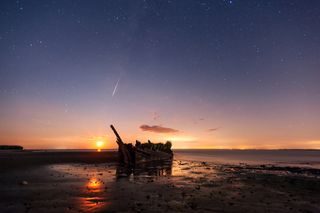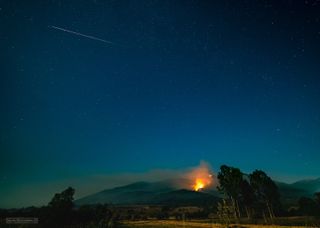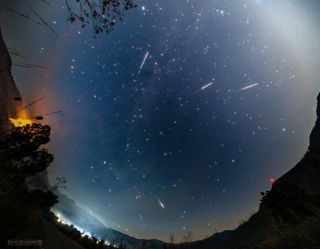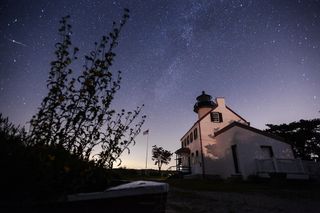Perseid Meteor Shower 2019 Dazzles Skywatchers Despite a Bright Moon

Viewing prospects for this year's Perseid meteor shower were not ideal, but that didn't stop the annual "shooting star" display from putting on a great show!
The annual Perseid meteor shower typically runs from mid-July to the end of August and peaks overnight on Aug. 12-13. This year, bright light from the waxing gibbous moon was expected to drown out fainter meteors, leading to less visible meteors in the night sky.
On an average year, the Perseids produce about 60 visible meteors per hour, depending on the amount of light pollution at a skywatcher's location. However, with the nearly-full moon lighting up the sky for most of the night, skywatchers reported seeing only 10-15 meteors per hour during the meteor shower's peak this year. But that didn't stop astrophotographers from capturing some amazing photos and videos of the Perseids — including some bright fireballs!
Gallery: More Amazing Perseid Meteor Shower 2019 Photos
The American Meteor Society (AMS), which runs a network of cameras across the United States, captured a bright fireball from six different all-sky cameras stationed along the central East Coast. In the video above, you can watch the meteor explode as it passes through Earth's atmosphere.
AMS members Ed Abel Mathias (West Virginia), Mike Hankey (Maryland), Peter Deterline (Pennsylvania) and Elizabeth Warner (University of Maryland) contributed their images to this compilation of the fireball.
Fireballs are exceptionally bright meteors that shine about as bright as the planet Venus in the night sky. The Perseid meteor shower typically produces more fireballs than any other annual meteor shower.
Get the Space.com Newsletter
Breaking space news, the latest updates on rocket launches, skywatching events and more!

Across the Atlantic in Macedonia, astrophotographer Stojan Stojanovski captured a breathtaking view of a Perseid meteor above a blazing wildfire on a mountainside.
Although the bright moonlight meant that he couldn't see as many meteors, the natural light lit up the mountain, allowing him to capture both the sky above and the ground below in detail. Stojanovski said he waited about 3 hours to capture a meteor above the burning mountain and saw about 10-15 meteors per hour in all.
To capture the photo above, Stojanovski used a Canon 5D Mark IV digital camera with a 16mm lens.

During that same photo shoot, Stojanovski switched to his Canon 6D and an 8mm fisheye lens to capture this "all-sky" composite of several Perseid meteors above the wildfire.
In the photo, a ring of smoke appears to circle around the meteor-filled sky. The Milky Way is also faintly visible in this view.

Near Paris, Texas, astrophotographer Tony Corso captured this stunning image of a Perseid meteor streaking through a starry sky above a barn near his home. If you look closely, you'll see the pinkish-orange meteor has a faint green tail.
The color of a meteor, or "shooting star," depends on its chemical composition. For the Perseids, the pink and green hues can be attributed to elements like calcium, sodium, magnesium, silicon and iron. As a meteor heats up in the atmosphere, these elements ionize and give off a bright glow.

In the photo above, taken near the East Point Lighthouse in Heislerville, New Jersey, a meteor appears to skewer a star in the top left corner.
However, that bright light is not really a star, astrophotographer Jeff Berkes told Space.com. Rather, the meteor "exploded at that point and made it look like a star," he said. "The images before and after that one does not have it in there! So crazy!"
Related: Perseid Meteor Shower 2019: When, Where & How to See It
For more amazing Perseid meteor shower photos, check out some of our top picks from Twitter below!
I shot to capture Delta Aquariid and Alpha Capricornid meteors, but captured more Perseids instead.View large, in HD: https://t.co/pB2x4iqF7F#Perseid #meteorshower #MonoBasin #California #D850 #astrophotography #StormHour #NikonNoFilter #Nikkor14_24 pic.twitter.com/0JmX8TGRmjAugust 8, 2019
The only meteor shot that I captured worth sharing. 2:51am today at Kingfisher Lakes in Daviess County, KY (8/11/19). #Perseid #Perseids #PerseidMeteorShower #Perseids2019 #Meteorshower #Nikon #NikonD7200 #Sigma #SigmaLenses #Sigma1850f28 #Kentucky #tristatewx #kywx pic.twitter.com/WeuA0zrcDiAugust 11, 2019
Perseid meteor shower as seen last night at the Elginfield Observatory. Lots of bright meteors. Should be a good show this coming weekend despite the moon. @WesternU @amsmeteors #Perseids pic.twitter.com/Zd1XS9va3IAugust 9, 2019
A stunning Perseid meteor at St Cwyfan’s last night @AngleseyScMedia @MilkyWay_Earth @ItsYourWales @WalesOnline @WalesCoastPath @ruthwignall @bbcweather @itvcoastcountry @kelseyredmore @500pxrtg pic.twitter.com/0jTCnQNr9fAugust 6, 2019
A couple #Perseid #meteors I caught last night, despite that bright moon 😍✨ #PerseidMeteorShower #MeteorShower #weather #stargazing #WV #WVstargazing #WVweather @StormHour @ThePhotoHour pic.twitter.com/B9uSSdGTquAugust 12, 2019
The Moon is sinking into the Adriatic Sea beneath the poorly visible Milky Way above it, while a bright Perseid meteor shoots to its right. Taken early this morning over Istra, Croatia, Aug 11th, 2019. pic.twitter.com/U6ZDI7yqrfAugust 11, 2019
- The Dazzling Perseid Meteor Shower of 2018 in Photos
- Top 10 Perseid Meteor Shower Facts
- Skywatching Spider Photobombs 2019 Perseid Meteor Shower
Follow us on Twitter @Spacedotcom and on Facebook.
Join our Space Forums to keep talking space on the latest missions, night sky and more! And if you have a news tip, correction or comment, let us know at: community@space.com.

Hanneke Weitering is a multimedia journalist in the Pacific Northwest reporting on the future of aviation at FutureFlight.aero and Aviation International News and was previously the Editor for Spaceflight and Astronomy news here at Space.com. As an editor with over 10 years of experience in science journalism she has previously written for Scholastic Classroom Magazines, MedPage Today and The Joint Institute for Computational Sciences at Oak Ridge National Laboratory. After studying physics at the University of Tennessee in her hometown of Knoxville, she earned her graduate degree in Science, Health and Environmental Reporting (SHERP) from New York University. Hanneke joined the Space.com team in 2016 as a staff writer and producer, covering topics including spaceflight and astronomy. She currently lives in Seattle, home of the Space Needle, with her cat and two snakes. In her spare time, Hanneke enjoys exploring the Rocky Mountains, basking in nature and looking for dark skies to gaze at the cosmos.
